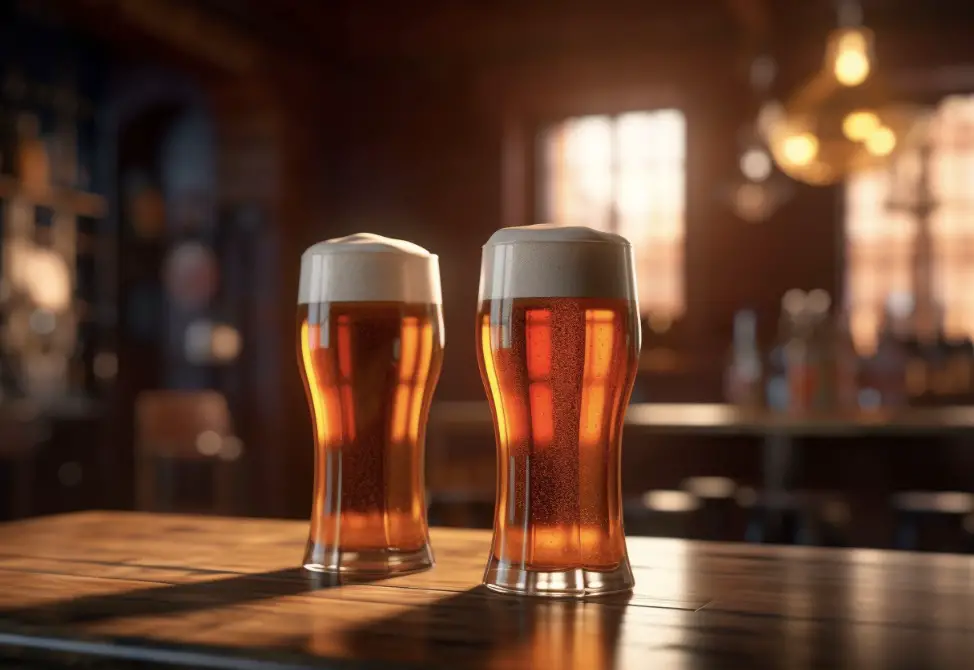Yes, you should cold crash your beer if you want to achieve a clearer, more professional-looking brew with a cleaner taste.
Cold crashing is a simple yet effective technique used by home brewers and professionals alike, and in this blog post, we’ll be diving deep into the world of cold crashing.
We’ll explore the benefits, the process, and address common concerns. By the end of this post, you’ll have all the knowledge you need to decide if cold crashing is right for you and your beer.
What is Cold Crashing?
Cold crashing is the process of rapidly lowering the temperature of your beer after fermentation to force the yeast, proteins, and other particulates to settle at the bottom of your fermenter. This allows you to transfer a clearer beer into your bottling bucket or keg, leaving the sediment behind.

The concept is similar to how a snow globe works. When you shake a snow globe, the particles inside the liquid are suspended and create a cloudy appearance. When you let the snow globe rest, the particles eventually settle to the bottom, leaving the liquid clear.
Brewers often cold crash their beer to improve its clarity, as well as to enhance its flavor and aroma. Cold crashing can also help prevent unwanted off-flavors and extend the beer’s shelf life.
Why Cold Crash Your Beer?
1. Improved Clarity
The primary reason most brewers choose to cold crash their beer is to achieve a clearer, more professional-looking brew. The process helps to drop out yeast and other particulates, leaving you with a beautiful, crystal-clear beer.

2. Enhanced Flavor and Aroma
Cold crashing can also help to improve the flavor and aroma of your beer. By removing excess yeast and other compounds, you’re left with a cleaner-tasting brew that allows the true flavors of your ingredients to shine through.
3. Prevention of Off-Flavors
Yeast and other particulates can sometimes contribute off-flavors to your beer. Cold crashing helps to remove these particles, reducing the risk of off-flavors in your final product.
4. Longer Shelf Life
By removing excess yeast and proteins from your beer, cold crashing can help extend its shelf life. This is especially important if you plan on storing your beer for an extended period or entering it into competitions.
How to Cold Crash Your Beer
1. Wait for Fermentation to Complete
Before you start cold crashing, make sure that fermentation is complete. Check the specific gravity of your beer with a hydrometer to ensure it has reached its final gravity. If you’re unsure, it’s better to wait a few extra days to ensure fermentation is truly finished.
2. Lower the Temperature
To begin cold crashing, you’ll need to lower the temperature of your beer rapidly. The ideal temperature for cold crashing is between 32°F – 40°F (0°C – 4°C). The colder the better, but be careful not to freeze your beer.
3. Maintain the Cold Temperature
Once you’ve reached the desired temperature, maintain it for 24-72 hours. The longer you cold crash, the more effective it will be at dropping out particulates. However, be aware that extended cold crashing can also strip away some of the desirable flavors and aromas of your beer.
4. Transfer Your Beer Carefully
After cold crashing, you’ll want to carefully transfer your beer to your bottling bucket or keg, taking care not to disturb the sediment at the bottom of your fermenter. A good tip is to use a siphon with a sediment tip to help prevent any unwanted particles from making their way into your final product.
Common Concerns About Cold Crashing
1. Oxidation
One concern that some brewers have about cold crashing is the risk of oxidation. As the beer cools, the air in the headspace of the fermenter can contract, potentially pulling in oxygen through the airlock. To minimize this risk, you can use a CO2-filled balloon or a one-way airlock to limit oxygen exposure.
2. Incomplete Carbonation
Another potential issue with cold crashing is incomplete carbonation when bottle conditioning. The cold temperatures can cause the yeast to become dormant, which may result in undercarbonated beer. To avoid this, simply let your beer warm up to room temperature before bottling to reactivate the yeast.
3. Gelatin or Other Fining Agents
Some brewers prefer to use gelatin or other fining agents to clear their beer rather than cold crashing. While these methods can be effective, they may also strip away some of the desirable flavors and aromas from your beer. Cold crashing provides a more gentle way to achieve clarity without sacrificing flavor.
Conclusion
Cold crashing your beer is a simple and effective way to achieve a clearer, more professional-looking brew with a cleaner taste.
If you’re looking to improve the appearance and flavor of your beer, consider giving cold crashing a try. Just remember to monitor the temperature carefully, and take precautions to minimize oxidation and other potential concerns.
To summarize, here are 10 facts about cold crashing:
1. Cold crashing is the process of rapidly lowering the temperature of your beer after fermentation to force particulates to settle.
2. It is primarily used to improve clarity in your beer.
3. Cold crashing can also enhance flavor and aroma by removing excess yeast and other compounds.
4. The technique can help prevent off-flavors and extend the beer’s shelf life.
5. Ideal cold crashing temperature is between 32°F – 40°F (0°C – 4°C).
6. You should maintain the cold temperature for 24-72 hours.
7. Cold crashing can cause concerns such as oxidation and incomplete carbonation.
8. To minimize oxidation risk, use a CO2-filled balloon or a one-way airlock.
9. To ensure proper carbonation, let your beer warm up to room temperature before bottling.
10. Cold crashing provides a more gentle alternative to using gelatin or other fining agents for clarity.
FAQs
Is cold crashing beer worth it?
Yes, cold crashing beer is worth it because it helps to clarify the beer by causing the yeast and other particles to settle at the bottom of the fermenter. This results in a clearer and cleaner tasting beer. Additionally, cold crashing can also help to reduce off-flavors and improve the shelf life of the beer.
Do you cold crash before or after carbonation?
It is recommended to cold crash before carbonation.
Should I cold crash my beer before bottling?
Cold crashing is a useful technique for clarifying beer before bottling. It involves lowering the temperature of the beer to near-freezing for a period of time, causing any remaining yeast or sediment to settle to the bottom of the fermenter. This can result in a clearer, cleaner-tasting beer. However, it is not strictly necessary and some brewers prefer to skip this step. Ultimately, it comes down to personal preference and the desired outcome for your beer.
Do you put carbonation drops before or after?
Carbonation drops should be added to the bottle before filling it with the beer or other carbonated beverage. This ensures that the drops dissolve evenly throughout the liquid and produce consistent carbonation levels.
How long should you cold crash for?
Cold crashing duration depends on the type of beer and the desired clarity. Generally, it is recommended to cold crash for 24-48 hours at a temperature between 0-4°C (32-39°F). However, some beers may require longer periods of cold crashing to achieve desired clarity.
When should I cold crash my beer?
You should cold crash your beer after fermentation is complete and before bottling or kegging, typically for 24-48 hours at temperatures around 35-40°F. This will help clarify the beer by causing yeast and other particles to settle to the bottom, resulting in a clearer and cleaner final product.




